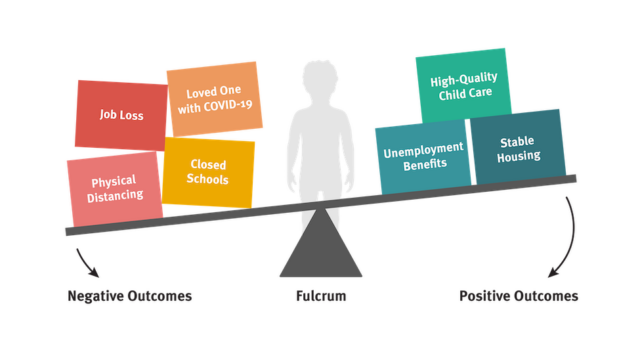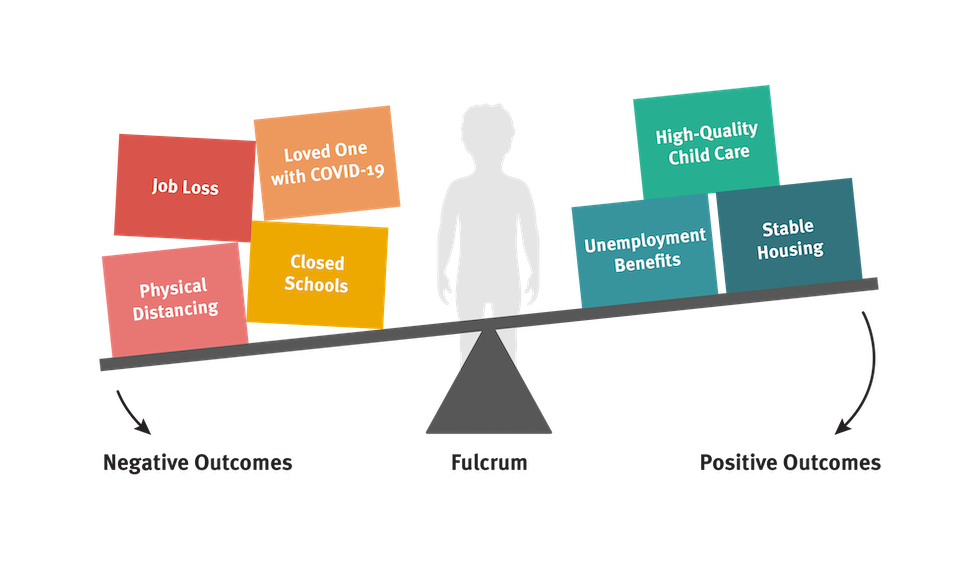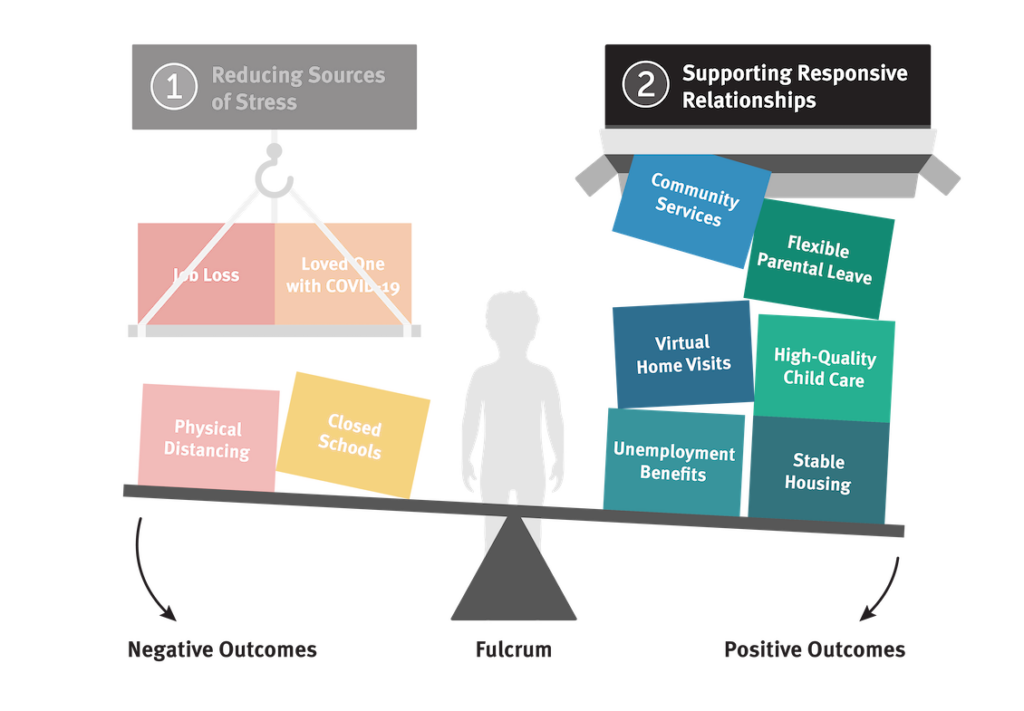How to Help Families and Staff Build Resilience During the COVID-19 Outbreak

The worldwide outbreak of the coronavirus disease (COVID-19) is a source of unexpected stress and adversity for many people. Resilience can help us get through and overcome hardship. But resilience is not something we’re born with—it’s built over time as the experiences we have interact with our unique, individual genetic makeup. That’s why we all respond to stress and adversity—like that from the COVID-19 pandemic—differently. Think of resilience as a seesaw or balance scale, where negative experiences tip the scale toward bad outcomes, and positive experiences tip it toward good outcomes.
For some people during the COVID-19 outbreak, the resilience scale may look like this:
The worldwide outbreak of the coronavirus disease (COVID-19) is a source of unexpected stress and adversity for many people. Resilience can help us get through and overcome hardship. But resilience is not something we’re born with—it’s built over time as the experiences we have interact with our unique, individual genetic makeup. That’s why we all respond to stress and adversity—like that from the COVID-19 pandemic—differently. Think of resilience as a seesaw or balance scale, where negative experiences tip the scale toward bad outcomes, and positive experiences tip it toward good outcomes. For some people during the COVID-19 outbreak, the resilience scale may look like this:

The point where the scale balances is called the “fulcrum,” and if it is more to one side or the other, it can make it harder or easier to tip the resilience scale to the positive. Everyone’s fulcrum is in a different spot—which explains why each person is different in how easily we can counterbalance hardships in life. The good news is that the fulcrum can be moved by developing a toolkit of skills you can use to adapt and find solutions. (More on that later.) So, what can we do to build up and strengthen resilience right now during the COVID-19 outbreak? And how can we build resilience to plan ahead for future times of crisis? The science of child development points to three ways we can affect experiences and the balance of the resilience scale:
Unload the Negative Side

We can lighten the load on the negative side of the resilience scale by reducing sources of stress for families and program staff. Many organizations are already doing this and can draw on their experience to prepare for possible future periods of physical distancing and shutdown. Reducing sources of stress may include:
- Helping families meet basic needs like food, shelter, diapers, health care, child care, and internet access or connecting them with programs that can help
- Guiding adults who are out of work through applying for financial assistance
- Creating and providing children’s activity kits that include things like coloring books, crayons and markers, word searches, puzzles, books, craft supplies, etc. to give parents and caregivers a break, even for a few minutes at a time
- Encouraging parents, program staff, and co-workers to practice self-care—even if it’s just taking a few minutes to themselves, going for a walk, or getting plenty of rest. Make sure staff are aware of and taking advantage of employee benefits such as employee assistance programs, mental health counseling, and paid time off.
Load Up the Positive Side

We can add to the positive side of the resilience scale by piling on positive experiences—especially through responsive relationships. The one thing that most children who develop resilience have in common is a stable, committed relationship with a supportive parent, caregiver, or other adult. Adults need those supportive relationships, too!
- If you work with families, you’ve likely already found new ways to check in with them while in-person visits aren’t possible—via phone calls or video chats, for example. The limitations of these alternatives may be a little frustrating, but remember that you’re not just checking in; you’re also providing parents with time to engage in a responsive relationship with a trusted adult during a time of physical isolation.
- Maintain and encourage connections with family and friends. Even though we’re all required to maintain physical distance, it’s important to call, video chat, email, or write letters to the people we care about to engage in responsive interactions, protect our emotional well-being, and manage the stress of living through this challenging time. (And, please access outside help and resources if you or someone else needs it.)
- Children’s development doesn’t pause during a crisis—and supporting that development and building resilience doesn’t have to take a lot of extra time or effort. Back-and-forth “serve and return” interactions are simple and free, and you can do them during ordinary moments throughout the day. If your baby makes a coo or gurgle during a diaper change, make a sound back. If your toddler points to something, point at it too and say what the object is. Playing with a child is a great way to engage in serve and return—and relieve some stress for all! (See this how-to video and step-by-step guide for more examples of serve and return.)
Move the Fulcrum

We can make it easier for a scale to tip toward positive outcomes by strengthening core skills. All of us need executive function and self-regulation skills to manage daily life, but stress makes it more difficult to use the skills we have. During the COVID-19 pandemic, we need these core skills for things like planning less frequent trips to the grocery store or market, filling out forms for relief funds or loans, navigating support programs, and for managing work, home, and caring for children. Adults can strengthen these skills with small but helpful supports, like:
Creating step-by-step checklists for accessing relief funds and filling out important applications
Sending or signing up for text reminders of important appointments
Using tools such as grocery list apps, menu planners, and daily schedules (and posting them for the whole family to see)
During a crisis like the COVID-19 outbreak, families need their immediate, basic needs met before they can focus on anything else. But, when the crisis is over, longer-term programs that support adults and children in building and practicing their core skills will again be necessary and effective.
What’s next? Learn more about these three principles and resilience. See more resources related to COVID-19. Contact the Center for help in applying these three principles to your work.